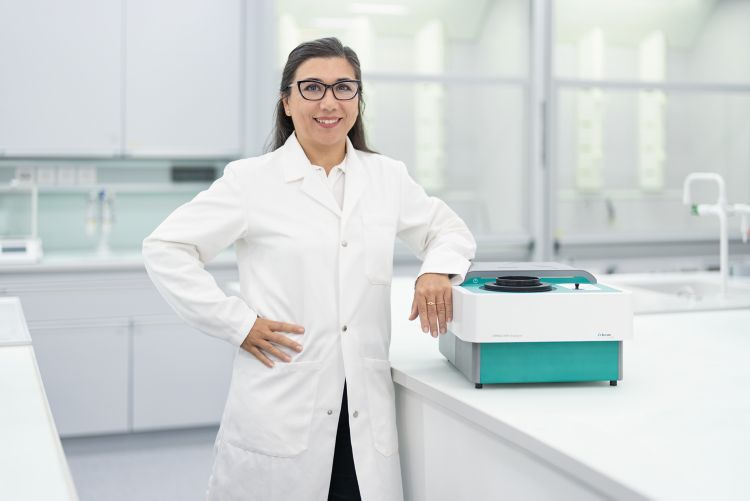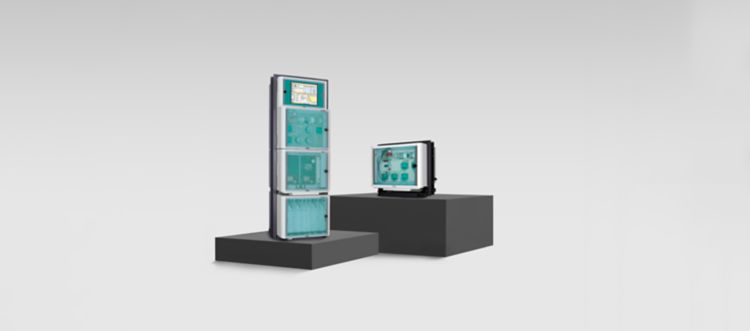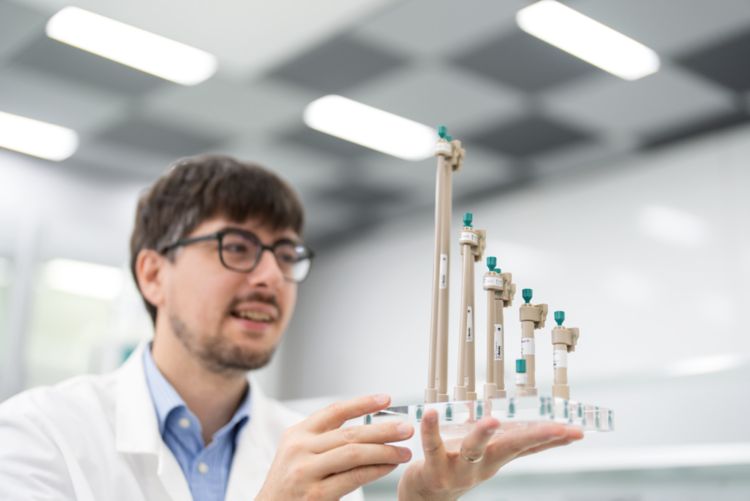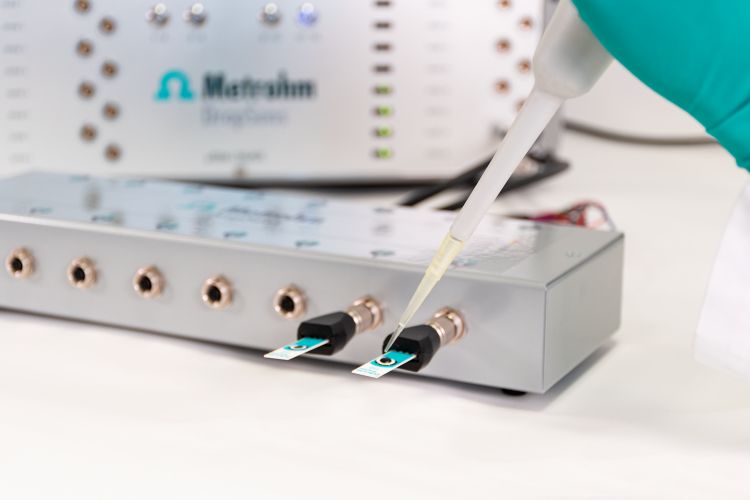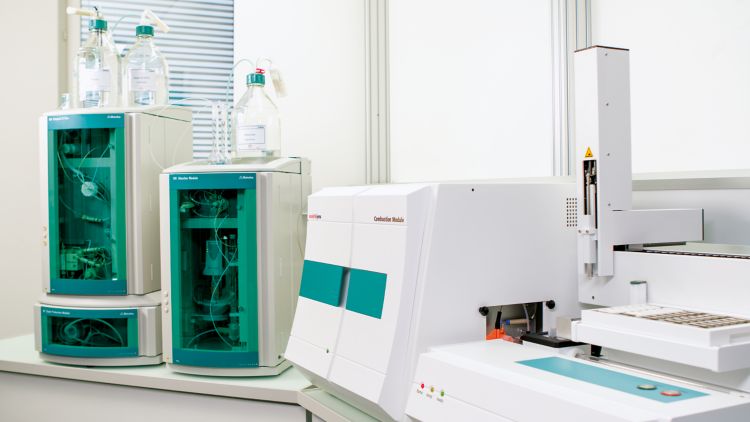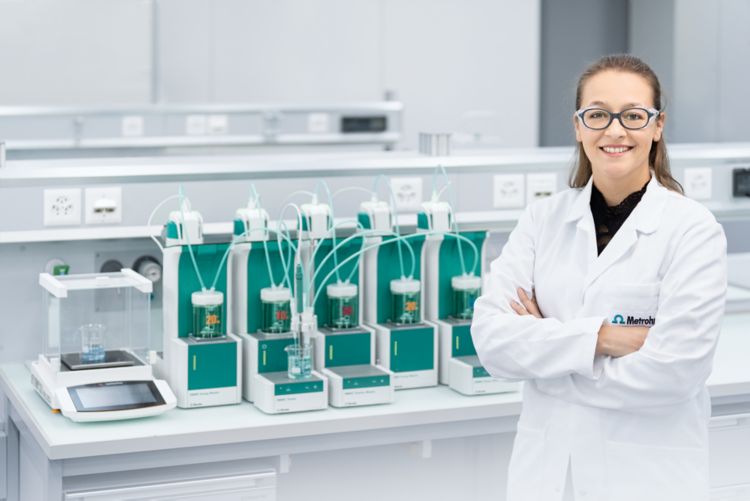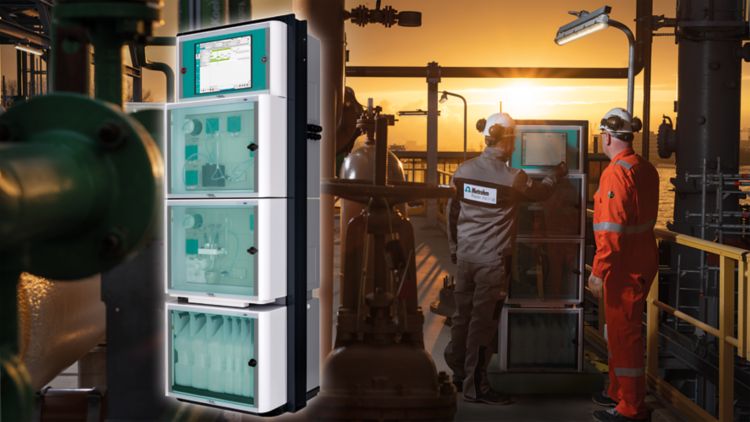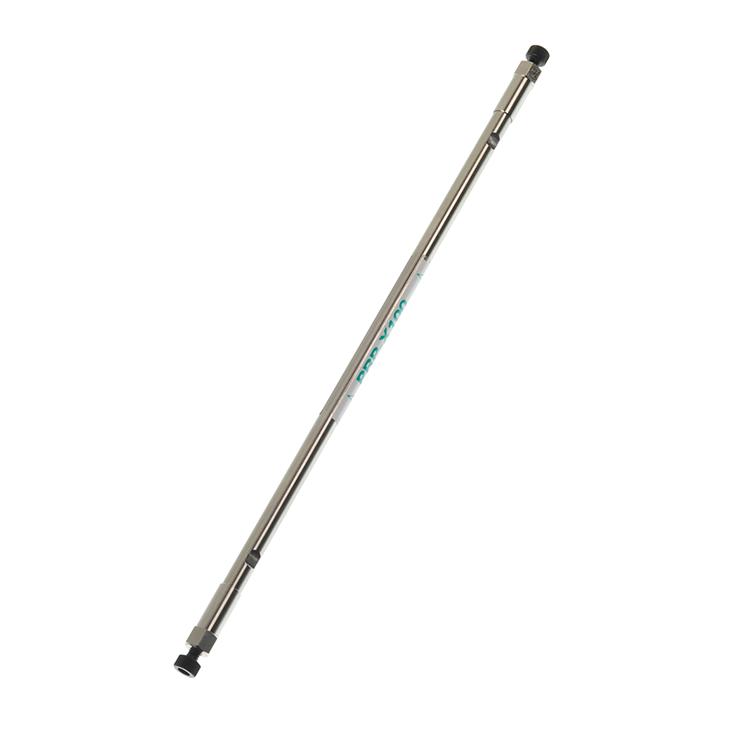Sök
Produktfamiljer
Produktfamiljer (71)Produktmodeller
Produktmodeller (715)Applikationer
Applikationer (2250)Utbildning & webbinarier
Eventer (3)Elektroder
Elektroder (531)Kolonner
Kolonner (155)Accessories
Reservdelar (2232)Programvara
Software (266)Manualer och broschyrer
Dokument (2632)Inspirerande inblick i industrin
Inblick i industrin (178)Annat innehåll
Innehåll (104)Nyheter
Nyheter (86)Support & service i särklass
Support & service (77)Utbildning & webbinarier
Webinars (76)Columns for IC
Ion chromatography columns from Metrohm include separation columns, guard columns, precolumns, trap columns, accessories for columns, and more.
QTRam
Kvantitativ Transmissions-Raman för likformighetstestning av fasta doseringsformer.
2035 Processanalysatorer
Processanalysatorer tillgängliga i potentiometriska, fotometriska och termometriska versioner med valfri ytterligare pH- och konduktivitetsmätning.
202X-serien
Singelmetoder, processanalysatorer för övervakning av kemikalier, vatten och avloppsvatten med titrering, pH, ISE eller fotometrimetoder.
Elektrokemiluminescens
Mångsidighet, enkelhet, förbättrad synkronisering och känslighet för ECL-analystekniken.
ProTrode pH-elektroder
Undersök och förstå processens beteende med pH-mätningar inline
PTRam Analyzer
Inline self-calibrating process development Raman.
μStat-i MultiX
Flerkanalig bipotentiostat, galvanostat och impedansanalysator (med MultiplEIS®-teknologi) för multi-användare och multidisciplinär elektrokemisk forskning.
Dosimat plus
Vätskehanteringssystem för fristående användning med manuell styrning in eller som automatisk doseringsanordning för Titrino plus titratorer.
846 Dosing Interface
Vätskehanteringsenhet som styr upp till fyra doseringsenheter, vilket ger flexibilitet för olika vätskehanteringsuppgifter i labbet. Enheten kan användas som ett fristående instrument eller som ett tillägg till befintliga Metrohm-system för att öka automationsgraden.
2.1001.0110
OMNIS Basic Titrator without stirrerInnovative, modular potentiometric OMNIS Titrator for endpoint titration. Thanks to 3S Liquid Adapter technology, handling chemicals is safer than ever before. The titrator can be freely configured with measuring modules and cylinder units and can have a stirrer added as needed. If required, the range of functions of the OMNIS Basic Titrator can be extended with a corresponding software function license. Control via PC or local network; Can be supplemented with magnetic stirrer and/or rod stirrer; Various cylinder sizes available: 5, 10, 20 or 50 mL; Connection option for up to four additional titration or dosing modules for additional applications or auxiliary solutions; Liquid Adapter with 3S technology: Safe handling of chemicals, automatic transfer of the original reagent data from the manufacturerMeasuring modes and software options:; Endpoint titration: "Basic" function license; Endpoint and equivalence point titration (monotonic/dynamic): "Advanced" function license; Endpoint and equivalence point titration (monotonic/dynamic) with parallel titration: "Professional" function license;
2.1008.2010
Eco Titrator SaltThe compact Eco Titrator with integrated magnetic stirrer and touch-sensitive User Interface is ideal for routine analysis. It provides GLP-compliant results with minimum space requirements at all times (approx. DIN A4).The Eco Titrator Salt plus offers you the complete package for the analysis of chloride in a wide variety of samples. The package contains a titrator, a 10 mL cylinder unit and an Ag Titrode, a maintenance-free electrode for precipitation titration with silver nitrate.
2.1010.1010
OMNIS Sample Robot S Pick&PlaceOMNIS Sample Robot S with a "Peristaltic" (2-channel) pump module and a Pick&Place module in addition to extensive accessories for the direct transition to fully automatic titration. The system provides space in two sample racks for 32 sample beakers of 120 mL each. This modular system is supplied completely installed and can thus be put into operation in a very short time.The system can also be extended upon request to include two additional peristaltic pumps and another Pick&Place module, thus doubling the throughput. If additional workstations are required, then this Sample Robot is already able to be expanded to become an L-sized OMNIS Sample Robot, thus enabling samples from seven racks to be processed in parallel on up to four Pick&Place modules and quadrupling the sample throughput.
2.858.0020
858 Professional Sample Processor – PumpThe 858 Professional Sample Processor – Pump processes samples from 500 µL to 500 mL. The sample transfer takes place either with the installed bidirectional two-channel peristaltic pump or with an 800 Dosino.
2.921.1310
NIRS XDS MasterLab AnalyzerRapid, nondestructive analyses of tablets, capsules and other solid-state dosage forms.The NIRS XDS MasterLab Analyzer enables the rapid, nondestructive analyses of solid-state dosage forms such as tablets, capsules, film-coated tablets, gel tablets and gel capsules for manufacturers in the pharmaceuticals industry. Solids in vials can also be analyzed with the NIRS XDS MasterLab Analyzer. The analysis takes place in reflection or transmission mode. The sample input proceeds via a sample slide that can be moved in x and y direction and that is designed for trays with several tablets and/or vials. Analyses of individual samples are optimized with an iris. An optionally available coarse granular sample cell for coarse granular substances extends analysis to include practically all solid forms ranging from fine powders to coarse granular materials, e.g., pellets and flakes.
2.922.1000
NIRS DS2500 Polymer AnalyzerRobust near-infrared spectroscopy for quality control of polymers, not only in laboratories, but also in production environments.The NIRS DS2500 Polymer Analyzer is the tried and tested, flexible solution for quality control and routine analysis of PE, PP, PET, polyamide, and other polymers in solid form along the entire production chain. Resistant to dust, moisture, vibrations, and temperature fluctuations, the NIRS DS2500 Polymer Analyzer is not only suitable for laboratory use, but also use in harsh production environments.The NIRS DS2500 Polymer Analyzer covers the full spectral range from 400 to 2,500 nm and delivers accurate results in less than one minute. The NIRS DS2500 Polymer Analyzer is ready for immediate use through pre-calibrations for PE, PP, PET, and polyamide (PA 6) and, thanks to its simple operation, supports users in their day-to-day routine tasks.
2.945.0010
945 Professional Detector Vario – ConductivityIntelligent stand-alone detector equipped with a high-performance IC Conductivity Detector. For use with intelligent IC instruments or as independent conductivity detector.
A062029010C
2029 Process PhotometerThe 2029 Process Photometer performs sensitive photometric absorption measurements in the visible light range. Detection limits in the low ppb range make this an attractive instrument for a variety of applications.At the heart of the analyzer is a high performance compact photometer module ready for 24/7 online measurement. It comprises a thermostated cuvette with 3 cm light path and LED technology, ensuring stable, accurate measurements no matter the environment. The color development stabilization is automatically detected by making use of differential absorbance measurements. Photometric laboratory methods can be easily transferred to the 2029 Process Photometer, eliminating any bias in results for improved process validation.Several markets are a perfect fit for the 2029 Process Photometer such as chemical, environmental, semiconductor, petrochemical, food and beverage, potable water, and energy/power.Selected applications include:Phosphate; Silica; Chlorine; Nickel; Zinc; Copper; Chromium; Ammonia; Nitrate; Nitrite; Hardness; and more;
BWT-840000341
NanoRam Handheld Raman SpectrometerThe NanoRam is a state-of-the-art, handheld Raman instrument for nondestructive identification and verification of incoming raw materials such as APIs, excipients, and intermediates. Compact and flexible, the NanoRam can be used by non-technical users to rapidly identify samples in the warehouse, on the loading dock, or in the lab, minimizing quarantine areas and expediting materials through the manufacturing lifecycle. Utilizing Raman technology, nondestructive analysis can be performed through transparent containers, maintaining the volume and integrity of the sample.The NanoRam meets the general requirements of Raman spectroscopy methods, including all the requirements of the US Pharmacopeia General Chapter <858>, European Pharmacopeia 2.2.48, Japanese Pharmacopeia 2.26, as well as the People’s Republic of China Pharmacopeia Guidelines on Raman Spectroscopy. Handheld Raman spectrometers support companies in compliance with the PIC/S & GMP guidelines regarding 100% identity assurance for starting materials. The NanoRam is fully compliant with the US FDA 21 CFR Part 11 and Part 1040.10, and can play an integral role in cGMP-compliant facilities. Full training and support services are available, including IQ/OQ/PQ/DQ implementation services as well as method and/or new library development support.
BWT-840000880
i-Raman EX Portable Raman SpectrometerThe i-Raman® EX is part of our award-winning series of i-Raman portable Raman spectrometers with our patented CleanLaze® laser with 1,064 nm laser excitation. Using a high-sensitivity InGaAs array detector with TE deep cooling, high dynamic range, and a high throughput spectrograph design, this portable Raman spectrometer delivers a high signal-to-noise ratio without inducing autofluorescence, making it possible to measure a wide range of natural products, biological samples (such as cell cultures), and colored samples.The i-Raman EX provides a spectral coverage range from 100 cm-1 to 2,500 cm-1, enabling you to measure across the entire fingerprint region. The system’s small footprint, lightweight design, and low power consumption ensure research-grade Raman analysis capabilities at any location. The i-Raman EX comes equipped with a fiber probe and an XYZ-positioning-stage with probe holder. It can be used with a range of sampling accessories to facilitate measurements on a wide range of different samples. For expanded analysis capabilities, it can be used with our proprietary BWIQ® multivariate analysis software or BWID® identification software. With the i-Raman EX, you always have a high precision Raman solution for qualitative and quantitative analysis without fluorescence.
- 8.000.60098.000.6009Determination of lanthanides by ion chromatography using non-suppressed conductivity and UV/VIS detection
The simultaneous ion chromatographic determination of trace-levels of lanthanides (or lanthanoides) was achieved by using either direct non-suppressed conductivity detection or UV/VIS detection after post-column reaction (PCR) with arsenazo III at 655 nm. Conductivity detection under isocratic conditions resulted in an overall analysis time of approx. 70 minutes. In contrast, the determination of the lanthanides via gradient elution and subsequent spectrophotometric detection of the arsenazo III-lanthanide(III) complexes was performed within 22 minutes. Besides the outstanding analysis time, UV/VIS detection excelled by its enhanced selectivity and sensitivity and did not suffer from interferences by ubiquitous non-lanthanide impurities such as iron(III) or other transition metals. For both conductivity and spectrophotometric detection, the inclusion of sample preconcentration steps lowered the limit of detection (LOD) to the sub-ppb range.
- 8.000.60108.000.6010Inline sample preparation – An effective tool for ion analysis in pharmaceutical products
By means of azide analysis in Irbesartan a simple, fast, precise and accurate ion chromatographic method for the determination of traces of inorganic contaminants in pharmaceuticals is described. Traces of toxic azides in pharmaceutical products can accurately be determined in the sub-ppb range after Metrohm Inline Matrix Elimination using isocratic ion chromatography (IC) with suppressed conductivity detection. While the azide anions are retained on the preconcentration column, the interfering pharmaceutical matrix is washed away by a transfer solution, ideally consisting of 70% methanol and 30% ultrapure water. The analytical setup provides a well-resolved azide peak and thus alleviates the common drawback of excipient interferences, especially from the nitrate anion. Calibration with azide standards is linear over the range of 5…80 ppb, providing a coefficient of determination of 0.9995. The limit of detection (LOD) and the limit of quantification (LOQ) of azide in Irbesartan are 5 and 30 µg/L respectively; the relative standard deviations (RSD) for the peak area, peak height and retention time being smaller than 3.9%. Robustness testing involved variation of column oven temperature and composition of the transfer solution and, in terms of peak area, provided RSDs smaller than 2.8% and 3.1% respectively.
- 8.000.60118.000.6011Ion chromatographic determination of anions, cations and organic acids in biofuels
Quality and process control of biofuels require straightforward, fast and accurate analysis methods. Ion chromatography (IC) is at the leading edge of this effort. Traces of anions in a gasoline/ethanol blend can accurately be determined in the sub-ppb range after Metrohm Inline Matrix Elimination using anion chromatography with conductivity detection after sequential suppression. While the analyte anions are retained on the preconcentration column, the interfering organic gasoline/bioethanol matrix is washed away.Detrimental alkali metals and water-extractable alkaline earth metals in biodiesel are determined in the sub-ppm range using cation chromatography with direct conductivity detection applying automated extraction with nitric acid and subsequent Metrohm Inline Dialysis. Unlike high-molecular substances, ions in the high-ionic strength matrix diffuse through a membrane into the low-ionic water acceptor solution. In biogas reactor samples, low-molecular-weight organic acids stem from the biodegradation of organic matter. Their profile allows important conclusions concerning conversion in the anaerobic digestion reaction. Volatile fatty acids and lactate can be accurately determined by using ion-exclusion chromatography with suppressed conductivity detection after inline dialysis or filtration.
- 8.000.60128.000.6012Automated logical dilution for ion chromatographic determinations
The combination of 850 Professional IC, 858 Professional Sample Processor, Dosino and MagIC NetTM software offers a variety of sophisticated ion chromatographic sample preparation techniques. One of these is the automated inline dilution of samples.After the first sample injection, MagIC NetTM verifies if the area of the sample peak lies within the calibration range. If the measured peak area is outside these limits, the software calculates the appropriate dilution factor, dilutes and automatically re-injects the sample. For all investigated ions (Li+, Na+, K+, Ca2+, Mg2+, F-, Cl- , NO2-, Br-, NO3-, SO42- ), automated logical dilution yielded coefficients of determination (R2) better than 0.9999. Direct-injection recoveries for cations and anions were within 98.6…99.5% and 93.4…100.4% respectively. In contrast, after logical dilution, recoveries for cations and anions were within 100.1…102.9% and 98.2…102.6% respectively. The relative standard deviations for all determinations involving diluted sample solutions were smaller than 0.91%.
- 8.000.60138.000.6013Analysis of produced water contaminants by ion chromatography
The analytical challenge treated by the present work consists in detecting sub-ppm quantities of bromide, sulfate, aliphatic monocarboxylic acids and several alkaline earth metals in the presence of very high concentrations of sodium and chloride. Bromide, sulfate, acetate and butyrate can be reliably determined by suppressed conductivity detection. Due to matrix effects, propionate can only be detected qualitatively. This drawback can be overcome by coupling the ion chromatograph (IC) to a mass spectrometric (MS) detector. This results in reduced matrix interferences and significantly enhanced sensitivities. The cations magnesium, barium and strontium are determined by non-suppressed conductivity detection.
- 8.000.60148.000.6014Determination of anions and cations in aerosols by ion chromatography
The study of adverse effects of air pollution requires semi-continuous, rapid and accurate measurements of inorganic species in aerosols and their gas phase components in ambient air. The most promising instruments, often referred to as steam collecting devices, are the Particle-Into-Liquid-Sampler (PILS) coupled to wet-chemical analyzers such as a cation and/or anion chromatograph (IC) and the Monitoring instrument for AeRosols and GAses (MARGA) with two integrated ICs. Both instruments comprise gas denuders, a condensation particle growth sampler as well as pump and control devices. While PILS uses two consecutive fixed denuders and a downstream growth chamber, the MARGA system is composed of a Wet Rotating Denuder (WRD) and a Steam-Jet Aerosol Collector (SJAC). Although the aerosol samplers of PILS and MARGA use different assemblies, both apply the technique of growing aerosol particles into droplets in a supersaturated water vapor environment. Previously mixed with carrier water, the collected droplets are continuously fed into sample loops or preconcentration columns for on-line IC analysis. While PILS has been designed to sample aerosols only, MARGA additionally determines water-soluble gases. Compared to the classical denuders, which remove gases from the air sample upstream of the growth chamber, MARGA collects the gaseous species in a WRD for on-line analysis. In contrast to the gases, aerosols have low diffusion speeds and thus neither dissolve in the PILS denuders nor in the WRD. Proper selection of the ion chromatographic conditions of PILS-IC allows a precise determination, within 4 to 5 minutes, of seven major inorganic species (Na+, K+, Ca2+, Mg2+, Cl-, NO3- and SO4 2-) in fine aerosol particles. With longer analysis times (10-15 minutes) even airborne low-molecular-weight organic acids, such as acetate, formate and oxalate can be analyzed. MARGA additionally facilitates the simultaneous determination of HCl, HNO3, HNO2, SO2 and NH3.PILS and MARGA provide semi-continuous, long-term stand-alone measurements (1 week) and can measure particulate pollutants in the ng/m3 range.
- 8.000.60158.000.6015Effect of eluent composition and column temperature on IC column retention times
This work was carried out with a Metrosep C 2 - 150 separation column, the following eluent parameters being investigated: nitric, tartaric, citric and oxalic acid concentration and concentration of the complexing anion of dipicolinic acid (DPA). The aim was to determine the effect of these parameters plus that of the column temperature on the retention times of alkali metals, alkaline earth metals, ammonium and amines using ion exchange chromatography with non-suppressed conductivity detection. Due to similar affinities for the ion exchange column, transition metals are difficult to separate with the classical nitric, tartaric, citric and oxalic acid eluents. Partial complexation with the dipicolinate ligand significantly shortens the retention times and improves the separation efficiency. However, too strong complexation results in a rapid passage through the column and thus in a complete loss of separation. Apart from a change in the elution order of magnesium and calcium at high DPA concentrations, other non-amine cations are only slightly affected by the eluent composition. Irrespective of the tartaric acid and nitric acid concentration in the eluent, an increase in column temperature shortens the retention times and slightly improves the peak symmetries of organic amine cations, particularly in the case of the trimethylamine cation. In contrast, an increase in column temperature in the presence of DPA concentrations exceeding 0.02 mmol/L increases the retention time of the transition metals. Depending on the separation problem, variation of the pH value, the use of a complexing agent and/or an increase in column temperature are powerful tools for broadening the scope of cation chromatography.
- 8.000.60168.000.6016Advantages of multidimensional ion chromatography for trace analysis
The analytical challenge treated in the present work consists in detecting trace concentrations (ppb) of bromide in the presence of a strong chloride matrix. This problem was overcome by separating the bromide ions from the main fraction of the early eluting chloride matrix (several g/L) by applying two sequential chromatographic separations on the same column. After the first separation, the main fraction of the interfering chloride matrix is flushed to waste, while the later eluting anions are diverted to an anion-retaining preconcentration column. After elution in counter flow, the bromide ions are efficiently separated from the marginal chloride residues. The four-point calibration curves for bromide and sulfate are linear in the range of 10…100 µg/L and 200…800 µg/L and yield correlation coefficients of 0.99988 and 0.99953 respectively. For the method shown here, a second injection valve and a preconcentration column are the only additional devices needed to master this demanding separation problem.
- 8.000.60178.000.6017Determination of sulfide in mining leachates
Metal precipitation and cyanide recovery in the SART process (sulfidization, acidification, recycling, thickening) depend to a great extent on the sulfide concentration. Among the flow injection analysis methods coupled to wet-chemical analyzers, the combination of a gas diffusion cell with an ion chromatograph (IC) plus subsequent direct spectrophotometric detection has proven to be one of the most convenient methods of sulfide analysis.This paper deals with the determination of sulfide anions via the coupling of a gas diffusion cell to an IC with subsequent spectrophotometric detection.
- 8.000.60208.000.6020Titrimetric analyses of biofuels
Several testing methods such as the determination of the acid and the iodine numbers in biodiesel as well as the quantification of sulfate and chloride in bioethanol are described.
Imprint
Kontakt
Karriär
Find job offers at Metrohm: apprenticeships, jobs for beginners, or professionals around the world.
Val av preferenser
Produkter
Metrohms produktportfölj: titratorer, Karl Fischer-titratorer, jonkromatografer, pH- och jonmätare, Raman- och NIR-spektrometrar, elektrokemisk utrustning och processanalysatorer.
Titrering
Innovativa titratorer, titreringssystem, tillbehör och expertis från världens ledande leverantör av titreringslösningar.
Vitbok: FOS/TAC-kvot för optimering av metanproduktion från biomassa
Lär mer om hur du övervakar biogasfermentorn i metanproduktion med biomassa som en förnybar energikälla.
Karl Fischer-titrering
Kompletta lösningar för volymetrisk och coulometrisk vattenhaltsbestämning med Karl Fischer-titrering: Titratorer, tillbehör och kunskap från världens ledande leverantör.
Ny ASTM D8045: Termometrisk syratalsbestämning i råolja
Bestäm syratalet i råolja och petroleumprodukter med termometrisk titrering enligt ASTM D8045.
USP-rekommendationer: Övervinner manuell titrering
USP har publicerat rekommendationer om hur man omvandlar manuella titreringsmetoder till automatiska titreringsmetoder för farmaceutiska tester. Ladda ner vitboken och lär mer om hur du konverterar dina manuella titreringsmetoder och moderniserar dina farmaceutiska analystester.
6.06002.114
OMNIS Client/Server: 25 instrument licenses25 instrument licenses for operating 25 additional OMNIS instruments in the OMNIS Client/Server system.The following instruments are supported:OMNIS instruments; Metrohm USB devices; RS-232 instruments (e.g., balance);
6.06003.010
OMNIS Stand-Alone licenseEnables stand-alone operation of the OMNIS software on a Windows™ computer.Features:The license already includes one OMNIS instrument license.; Must be activated via the Metrohm licensing portal.; Not transferable to another computer.;
6.06003.012
OMNIS stand-alone license with 2 instrument licensesEnables stand-alone operation of the OMNIS Software on a Windows™ computer.Features:The license already includes two OMNIS instrument licenses.; Must be activated via the Metrohm licensing portal.; Not transferable to another computer.;
6.06003.110
OMNIS Client/Server license with 1 instrument licenseEnables client/server operation of the OMNIS software.Features:The software license already contains one instrument license.; Permits operation of up to 500 OMNIS Clients on one OMNIS Server.; Must be activated via the Metrohm licensing portal.; Not transferable to another computer.;
6.06004.010
Software License Compliance/Regulation Stand-AloneSoftware license for the use of the compliance functions in connection with a Software Stand-Alone License.
6.06004.011
Software License Compliance/Regulation Client/ServerSoftware license for the use of the compliance functionalities in connection with an OMNIS Client/Server Software License. The compliance functionalities are available to all OMNIS Clients.
6.06004.020
Software license 3rd Party Data Integration Stand-AloneThe software license enables data exchange between the OMNIS Software and third party software (e.g., LIMS).This software license requires a valid software license for OMNIS Stand-Alone.
6.06004.120
Software license 3rd Party Data Integration Client/ServerThe software license enables data exchange between the OMNIS Software and third party software (e.g., LIMS).This software license requires a valid software license for OMNIS Client/Server. This functionality is available to all OMNIS Clients.
6.06006.000
Function license Upgrade Basic-AdvancedFunction license for the upgrade of one OMNIS Titrator: Basic to Advanced.
6.06006.010
Function license Upgrade Basic-ProfessionalFunction license for the upgrade of one OMNIS Titrator: Basic to Professional.
DRP-110STR-U50
Streptavidin modified Screen-Printed Carbon ElectrodeStreptavidin modified Screen-Printed Carbon Electrodes provide a stable high affinity surface for a large amount of biotinylated molecules.
DRP-110SWCNT-U50
Single-Walled Carbon Nanotubes modified Screen-Printed Carbon ElectrodeSingle-Walled Carbon Nanotubes modified Screen-Printed Carbon Electrode designed for the development of (bio) sensors with an enhanced electrochemical active area.
DRP-110XTR-U50
Extravidin modified Screen-Printed Carbon ElectrodeExtravidin modified Screen-Printed Carbon Electrode. ExtrAvidin combines Avidin high specificity with low non-specific adsorption of Streptavidin. These SPCEs are designed for the development of (bio) sensors with an enhanced electrochemical active area.
DRP-4W110-U20
4 WEs Screen-Printed Carbon Electrode4 WEs Screen-Printed Carbon Electrode (1 Aux.: C; 1 Ref.:Ag). Aimed at detecting four signals simultaneously, allowing (differential) measurement of up to four analytes in the solution.
DRP-8W110-U20
8 WEs Screen-Printed Carbon Electrode8 WEs Screen-Printed Carbon Electrode (1 Aux.: C; 1 Ref.:Ag) Aimed at detecting eight signals simultaneously, allowing (differential) measurement of up to eight analytes in the solution.
DRP-8X110-U20
8X Screen-Printed Carbon Electrode8X Screen-Printed Carbon Electrode (Aux.: Carbon; Ref.:Ag) Screen-printed electrochemical array formed by eight 3-electrode electrochemical cells. Specially designed for the development of multiple simultaneous analysis.
DRP-96X110-U4
96X Screen-Printed Carbon Electrode96X Screen-Printed Carbon Electrode. Formed by 96 three-electrode electrochemical cells. Gold plated contact paths are printed in the backside of the plate
DRP-96X110CNT-U2
96X Multi-Walled Carbon Nanotubes modified Screen-Printed Carbon Electrode96X Multi-Walled Carbon Nanotubes modified Screen-Printed Carbon Electrode. Formed by 96 three-electrode electrochemical cells. Gold plated contact paths are printed in the backside of the plate
DRP-96X110CNT-GNP-U2
96X Multi-Walled Carbon Nanotubes-Gold Nanoparticles modified Screen-Printed Carbon Electrode96X Multi-Walled Carbon Nanotubes-Gold Nanoparticles modified Screen-Printed Carbon Electrode. Formed by 96 three-electrode electrochemical cells. Gold plated contact paths are printed in the backside of the plate
DRP-96X110GNP-U2
96X Gold Nanoparticles modified Screen-Printed Carbon Electrode96X Gold Nanoparticles modified Screen-Printed Carbon Electrode. Formed by 96 three-electrode electrochemical cells. Gold plated contact paths are printed in the backside of the plate
- 3 juni 2024Conservation of art using electrochemistry
Non-destructive methods like electrochemistry aid in analyzing and preserving artifacts. This blog outlines three examples of electrochemistry in art conservation.
- 23 sep. 2024Quality control of cathode materials
This article highlights several key parameters crucial for Li-ion battery cathode production quality and efficient recycling and the methods to analyze them.
- 1 maj 2023Easily measuring ORP values in real-life applications
The ORP kit from Metrohm DropSens is handy, reliable, and easy to use for reproducible measurement of oxidation-reduction potential in various situations. The multitude of requirements from several industries that must measure ORP fit perfectly with the advantages gained when using screen-printed electrodes and miniaturized instruments, including portability, accessibility, disposability, small sample sizes, and reliability.
- 12 juni 2023The future of ammonia production is electrochemistry
Ammonia is the most common and widely used nitrogen-based fertilizer. It is also viable as a safer hydrogen carrier in large quantities. Traditional ammonia manufacturing uses fossil fuel as a hydrogen source needed for the reaction. Commonly termed «green ammonia», electrochemically synthesized ammonia with the use of electricity from renewable sources is an interesting zero-carbon emission alternative.
- 7 aug. 2023Is having a service agreement important?
If analytical instrumentation is neglected, it may become unreliable and fall into disrepair. Non-compliance with regulatory requirements is also a concern in such situations. However, regular preventive maintenance as a part of a service agreement can help avoid these situations. Metrohm Service Agreements give you peace of mind with various maintenance plans suitable for any budget.
- 18 sep. 2023Intuitive spectroelectrochemistry: How user-friendly cells make analysis even easier
Spectroelectrochemistry (SEC) is an emerging analytical technique with great potential. While complex setups and data processing discouraged some researchers, the SPELEC instrument line, controlled by a single software, has made SEC more approachable. The development of user-friendly cells for different SEC configurations further simplifies measurements, making spectroelectrochemistry accessible to a wider audience.
- 3 apr. 2023History and analysis of vitamin C (ascorbic acid)
This article covers the history of vitamin C (ascorbic acid) and some of the different analytical methods used to determine it in various products (e.g., by titration, polarography, and ion chromatography).
- 26 juni 2023Frequently Asked Questions (FAQ) about Raman spectroscopy: Applications
Raman spectroscopy is a ubiquitous tool that can be used for many different purposes. This blog article answers some frequently asked questions about the suitability of Raman spectroscopy for various applications.
- 4 sep. 2023Streamline material inspection in regulated industries with new Raman USP library
Metrohm’s Raman systems and Comprehensive USP Raman Library support regulated industries such as pharmaceutical manufacturing: Streamline inspection of deliveries, reduce inspection resources, get the final product to the market faster.
- 30 okt. 2023A thermal rollercoaster: Unraveling temperature dependence in CVS determinations
Precision in PCB manufacturing demands accurate control of organic additives during copper plating. Cyclic Voltammetric Stripping (CVS) is used to quantify these additives, but temperature differences impact accuracy of the results. This article outlines the method for assessing organic additives in copper plating baths and explores temperature's influence on CVS measurements.
6.1005.030
Hamilton PRP-X300 - 250/4.0The Hamilton-PRP-X300 ion exclusion column is a cation exchanger column with low capacity. The combination of a polystyrene-divinylbenzene copolymer with sulfonic acid groups as ion exchanger is ideal for the solution of simple separation problems. This column features the possibility of determining the salts of organic acids, in particular the very sensitive determination of formate.
6.1050.450
Metrosep C 4 - 50/4.0The Metrosep C 4 - 50/4.0 is the shortest separation column in the Metrosep C 4 product range. With a capacity of 5 µmol (K+), it is particularly suitable for very rapid separations. The low capacity makes it possible to quickly analyze the earth alkaline metals with their delayed elution. Thanks to the short retention times, applications that, in terms of analysis duration, were previously possible only with an FIA system (Flow Injection Analysis system) can now be transferred over to ion chromatography.
6.1050.410
Metrosep C 4 - 100/4.0The 100 mm version of the Metrosep C 4 column is intended for rapid determinations of standard cations. Very short retention times are achieved; however the elution times of sodium and ammonium still differ by 25 s. When a special eluent is used, the six cations lithium, ammonium, sodium, calcium, magnesium and potassium can be determined in less than 5 minutes with the Metrosep C 4 - 100/4.0.
6.1050.420
Metrosep C 4 - 150/4.0The Metrosep C 4 - 150/4.0 is the universal standard column in cation analysis for accomplishing high separating efficiency in a short time. The Metrosep C 4 - 150/4.0 is the ideal separation column for the analysis of alkaline and earth alkaline metals in aqueous media.
6.1050.430
Metrosep C 4 - 250/4.0The Metrosep C 4 - 250/4.0 is the cation column with the greatest capacity in the C 4 series. It is predestined for applications which require the highest separating efficiency. Samples with extreme differences in concentrations can be analyzed reliably with this column. The performance capability of the column is demonstrated, for example, when analyzing feed water for which the requirement is the perfect quantification of 7 µg/L sodium in addition to 7 mg/L monoethanolamine (MEA). With the C 4 - 250/4.0, not only amines and transition metals, but also alkaline and alkaline earth metals can be determined in a single run.
6.1050.210
Metrosep C 4 - 100/2.0The short version of the Metrosep C 4 "Microbore" cation separation column with a 2 mm inner diameter is intended for rapid determinations of the standard cations. Very short retention times are achieved; however the elution times of sodium and ammonium still differ by 25 s. When a special eluent is used, the six cations lithium, ammonium, sodium, calcium, magnesium and potassium can be determined in less than 5 minutes with the Metrosep C 4 - 100/2.0. With its low eluent flow, this column is particularly suitable for IC-MS coupling.
6.1050.220
Metrosep C 4 - 150/2.0The Metrosep C 4 - 150/2.0 "Microbore" cation separation column is the universal standard column in cation analysis of "Microbore" separating columns. High separating efficiency in a short time. The Metrosep C 4 - 150/2.0 is the ideal separation column for the analysis of alkaline and earth alkaline metals in aqueous media. With its low eluent flow, this column is particularly suitable for IC-MS coupling.
6.1050.230
Metrosep C 4 - 250/2.0The Metrosep C 4 - 250/2.0 "Microbore" cation separation column is the cation column with the greatest capacity in the C 4 series with a 2 mm inner diameter. It is predestined for applications which require high separating efficiency. Samples with extreme differences in concentrations can be analyzed reliably with this column. The performance capability of the column is demonstrated, for example, when analyzing sodium traces in addition to monoethanolamine (MEA). With the C 4 - 250/2.0, not only amines and transition metals but also alkaline and alkaline earth metals can be determined in a single run. With its low eluent flow, this column is particularly suitable for IC-MS coupling.
6.1051.410
Metrosep C 6 - 100/4.0The 100 mm version of the Metrosep C 6 column is designed to determine standard cations, e.g. in drinking water. Excellent separation of sodium and ammonium is still achieved, despite the very short retention times. The higher capacity of the C 6 material permits larger sample volumes.
6.1051.420
Metrosep C 6 - 150/4.0The high-capacity C 6 material makes the Metrosep C 6 - 150/4.0 separation column the optimum solution for separating standard cations with high differences in concentration in conjunction with reasonable retention times. Drinking water with low ammonium contents can be determined with this column.
6.7301.100
Guide tubing for ABD (old)Guide tubing for Automatic Boat Driver of the Combustion Module (up to ABD serial number 1709 590).
6.7301.110
Hook for ABDQuartz glass hook for quartz glass boat in the Automatic Boat Driver of the Combustion Module.
6.7302.100
Quartz boat 40 x 9 mm (AJ)Quartz glass boat for sample injection in Combustion Module, 10 pcs.
6.7302.130
Ceramic boat 40 x 9 mm (AJ)Ceramic boat for sample injection in Combustion Module, 10 pcs.
6.7303.100
Glass vial, 1.5 mL, 100 piecesFor use with the following sample changers: Liquid Autosampler CIC (TEI), MMS 5000 Autosampler (AJ) and 889 Sample Center.
6.7303.110
Septum for 67303100, 100 piecesFor use with the 67303100 Glass vial on the following sample changers: Liquid Autosampler CIC (TEI), MMS 5000 Autosampler (AJ), and 889 Sample Center.
6.7302.110
Quartz vial, 6 x 18 mm, for CIC, 50 pcs.Sample vials made of quartz for Combustion IC. The sample vials are used when the sample contains alkali and/or alkaline earth cations which could affect the quartz combustion tube. These cations reaction with the quartz in the sample vial and are thus kept away from the combustion tube. Quartz wool (6.7302.120) is used to fix the samples in place in the sample vials.
6.7302.120
Quartz wool for 6.7302.110, 10 gQuartz wool for fixing the sample in place in the sample vial made of quartz (6.7302.110).
6.7301.150
Substrate made of quartz for liquid samplesSubstrate for liquid sample injections, 3 pcs.
6.7305.040
0.5 µm filter for LPG filter unit0.5 µm particle filter on the LPG connector.
- Metrohm IC Driver 2.2 for Empower
The Metrohm IC Driver 2.2 for Empower 3 enables the integration of Metrohm IC instruments in the software Empower 3 from Waters. Learn about the compatibility with Windows OS and find more information in applications notes.
- StabNet
Hitta information om kompatibilitet och ladda ner StabNet-programvaran för Rancimat- och Thermomat-instrumenten för stabilitetsmätning samt språkpaket.
- Programvara till bärbara 946 VA-analysator
Hitta information om kompatibilitet och ladda ner den senaste versionen av programvaran för Portable VA Analyzer.
- IP-kalkylator för 900 Touch Control ochTi-Touch
Ladda ner IP-kalkylatorn för att kontrollera om dina 900 Touch Control- och Ti-Touch-enheter samt måldatorn finns i samma nätverk.
- tiBase - Utgått
Ladda ner den senaste versionen av tiBase-programvaran.
- Document Finder
Find and download the brochure, manual, or technical specifications for your instruments.
- Installation
Korrekt installation och driftsättning av ett nytt instrument är avgörande för att säkerställa kvaliteten på analysresultaten. Dra nytta av vår erfarenhet och välj graden av dokumentation från vår Kompatibilitetsservice som passar dina behov.
- Titrering
Hitta användbara instruktioner och videohandledning om hur du arbetar med våra potentiometriska titreringar.
- Konditionering av de...Konditionering av den volymetriska KF-titrercellen
Video tutorials on how to fill and condition the volumetric titration cell.
- KF Titrering – Kondi...KF Titrering – Konditionering av den coulometriska KF-cellen
Lär dig hur du konditionerar din coulometriska Karl Fischer-cell.
- 23 mars 2020OMNIS möter Cubis® II
The laboratory balance Cubis® II from Sartorius has become a fully integrated module of the OMNIS platform from Metrohm.
- 9 juli 2015Sinne för detaljerna: utbildningsmaterial förklarar hur du kan skydda noggrannhet och tillförlitlighet för dina pH-mätningar
Sinne för detaljerna: utbildningsmaterial förklarar hur du kan skydda noggrannhet och tillförlitlighet för dina pH-mätningar
- 6 apr. 2021Jonkromatografi för exempelvis kolhydratanalys
Automatiserad bestämning av GOS, β-galaktooligosackarider och kolhydrater i nya livsmedel och snabbkaffe, viktiga anjoner samtkatjoner i öl och organiska syror i vin.
- 11 feb. 2021tiamo 3.0 släpps
Titreringsprogramvaran tiamo version 3.0 släppt.
- 17 mars 2025Digitalize your titration!
The ChemiSphere App from Merck is a secure and convenient way to seamlessly transfer data from reagent bottles to the OMNIS Titrators from Metrohm. This app closes the final gap to ensure complete data integrity in titration.
- 5 jan. 2023Metrohm wins award from The National Institute on Drug Abuse (NIDA)
Metrohm’s SERS expert and inventor of P-SERS strips, Dr. Wei Yu, has been awarded a grant from the National Institute on Drug Abuse (NIDA) for a portable Raman-based postmortem toxicology screening method.
- 21 feb. 2023Tips and tricks for Karl Fischer water determination using the oven method
A free joint webinar with Honeywell on March 15 presents the benefits of the Karl Fischer oven method. The oven method is the solution for matrices that cannot be analyzed by direct Karl Fischer titration because they release the contained moisture only very slowly, only at high temperatures, because they are poorly soluble in KF solvents, or because they undergo side reactions with the KF reagent.
- 3 mars 2023Monitoring PFAS and other organically bound halogens in water and wastewater
In a joint webinar, Analytik Jena and Metrohm present Combustion Elemental Analysis and Combustion Ion Chromatography (CIC) as a viable solution to determine the sum parameters AOX and AOF.
- 29 mars 2023Metrohm helps pharma to bring their USP methods up to date
The United States Pharmacopeia (USP) has modernized a substantial number of existing monographs to include ion chromatography (IC) methods for numerous pharmaceutical assays of APIs as well as analysis of impurities and excipients. Metrohm has cooperated with USP in this project as a partner and several of these monographs have been validated with Metrohm instruments and columns.
- 3 apr. 2023How near-infrared spectroscopy can make your QC faster and reduce costs
In a free educational webinar, Dave van Staveren and Wim Guns from Metrohm International Headquarters explain how near-infrared spectroscopy works and they present several application examples from the chemical, petrochemical, polymer, pharmaceutical, and the food & beverage industry.
- 8.000.52208.000.5220Brochure: Biogas production – reliable online, inline, and atline analyzers for waste recycling
Constant monitoring in biogas production is indispensable for reducing waste while at the same time increasing profits. Metrohm Process Analytics provides you with a variety of analyzers and methods for that purpose.
English
- 8.000.52228.000.5222Brochure: Online measuring instruments for power plant analysis – Monitoring and protection against corrosion
In power plants, corrosion is the primary factor leading to costly and critical outages. The water steam cycles in fossil and nuclear power plants are inherently prone to corrosion, as metal components are constantly in contact with water. Measures to monitor or prevent corrosion are crucial in this context. Metrohm offers a range of instruments and methods for measuring parameters related to corrosion.
English
- 8.000.52238.000.5223Brochure: Electrocatalysis – Complete solutions for electrocatalysis and forced convection measurements.
The present brochure presents products which are used either with electrocatalysis or for forced convection measurements.
English
Andra språk
- 8.000.52248.000.5224Brochure: Vision Air – Universal Vis-NIR spectroscopy software
This brochure gives you an insight into Metrohm's "Vision Air" Vis-NIR spectroscopy software. Vision Air is a modern, intuitive and simple to operate software solution for practically universal application in quality assurance.
English
Andra språk
- 8.000.52258.000.5225Brochure: The kappa number, the density and the strength parameter in wood pulps – Rapid and simple determination with near-infrared spectroscopy
Paper quality is largely dependent on the physical and chemical properties of the wood pulp. The kappa number, the density and other parameters were often determined in the past using time-intensive analyses. The solution described here offers you a number of advantages over the conventional method. The present brochure describes the application possibilities of NIR instruments in the paper and wood pulp industry.
English
- 8.000.52278.000.5227Brochure: Semiconductor industry – Reliable online, inline and atline solutions for your process requirements.
Integrated connections are an essential part of modern electronic devices. The present brochure describes the application possibilities and advantages of Metrohm process analysis instruments in the semiconductor industry.
English
- 8.000.52288.000.5228Datasheet: Mira M-3 portable Raman spectrometer
The Mira M-3 Raman spectrometer is a robust and reliable, portable spectrometer for material identification and verification. The present datasheet shows the different specifications of the Mira M-3 Raman spectrometer.
English
- 8.000.52298.000.5229Brochure: Textile industry – Reliable online, inline, and atline solutions for your process analytics requirements.
An enormous array of clothing and other articles made of textiles are available on the market, manufactured from either natural or synthetic fibers. These fibers are later dyed and, depending on the material, specific dyeing techniques are used. Continuous quality tests and analyses are required for optimum performance of these techniques. This brochure provides you with insights into the different analyses.
English
- 8.000.52318.000.5231Brochure: One-stop-shop for spectroelectrochemistry
This brochure provides further information about the Autolab Spectrophotometer. Autolab supplies the complete spectroscopy setup as well as the electrochemical instruments with total flexibility in choice of potentiostat, all controlled from the NOVA software package.
English
- 8.000.52328.000.5232Brochure: Total solutions for electrocatalysis research
This brochure provides further information about solutions for electrocatalysis research. Two options, ECAT-Compact and ECAT-Complete, are now available.
English






















